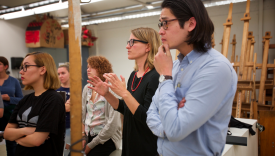Art & the History of Art 417 - The Mughal Empire: Art, Architecture, and Power in South Asia
M | 1:00 PM - 3:45 PM
(Offered as ARHA 417, ARCH 417, and ASLC 417) Founded in 1526 by a Muslim prince from Central Asia, the Mughal dynasty dominated the political landscape of South Asia (including present-day India, Pakistan, Afghanistan, and Bangladesh) until the middle of the nineteenth century. The influence of the Mughal Empire also extended well beyond South Asia, making it one of the most important players in the premodern global arena. This course will examine the great range of art and architecture produced for the Mughal emperors and members of their court, placing special emphasis on how these materials (and their makers) helped create a powerful, multifaceted image of empire. We will explore illustrated manuscripts and monumental architecture, including the justly famous Taj Mahal, but also expand our purview to consider less studied objects such as carved jade vessels, inscribed gems, inlaid metalwork, and textiles. We will pay particular attention to Mughal encounters with the arts of India's Hindu kings, the Safavid Empire, the Jesuit missionaries, the royal courts of Europe, and the British East India Company. We will also consider how race, gender, sexuality, and colonialism factored within these contexts. Films and field trips to local museum collections will supplement assigned readings and lectures. Participation in class discussion, a significant component of the course, is expected. No previous background is presumed, and all readings will be available in English.
Limited to 18 students. Spring 2025: Professor Rice.
How to handle overenrollment: Priority given to ARHA, ARCH, and ASLC majors
Students who enroll in this course will likely encounter and be expected to engage in the following intellectual skills, modes of learning, and assessment: Close analysis of historical evidence, which may include written documents, images, and architecture from the historical period under study. Exploration of scholarly, methodological, and theoretical debates about historical topics. Extensive reading, varying forms of written work, and intensive in-class discussions.


